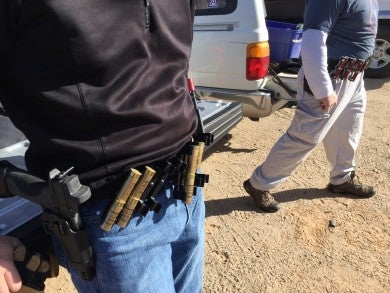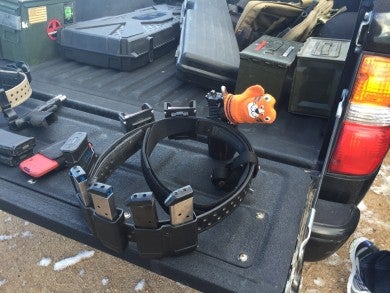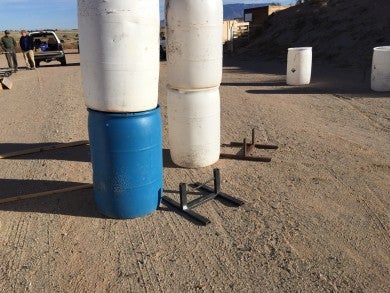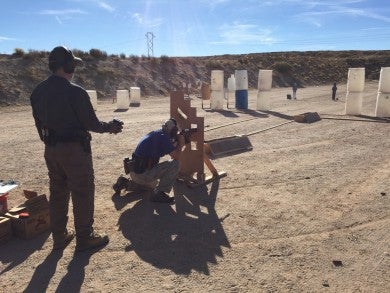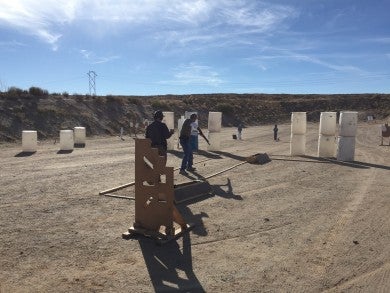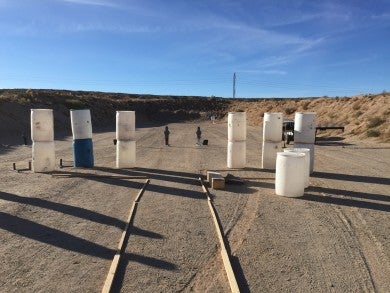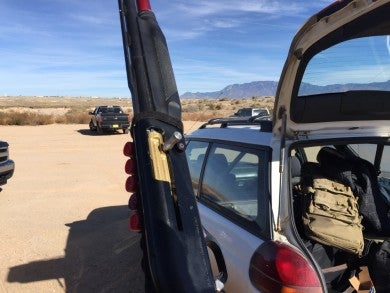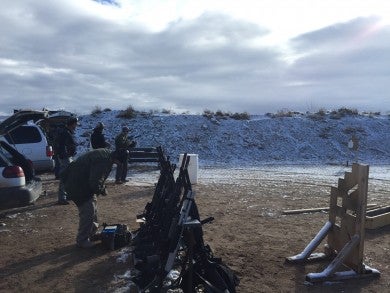I’ve never really been one for competitions. Not because I am particularly terrible. It is just not really my thing. I’m fine competing with myself, and working on self-improvement but that is generally the extent of my competitive nature. Even when I do CrossFit (yes, I’m one of those), I rarely record my scores on the board. I’m writing this article mainly for people who are interested in getting involved in the “sport” of 3-Gun (is it a sport if it doesn’t have a ball?), but aren’t really sure what it is, aren’t really interested in the “competition” aspect, or just may be “intimidated” by videos (or other media) about it.
How I Got Suckered Into 3-Gun…
Romo (the house armorer of BMC Tactical, my favorite local shop and FFL) suggested that I go to a 3-Gun match with him. I was like “Pshaw! No way.” He laughed and said it would not be like what I thought (and I’ll admit my opinion was heavily clouded by watching 3-Gun Nation and seeing a couple of Youtube videos, which is clearly the factual basis of any topic). To my uninitiated eye it looked like an ultra competitive event. Pictures of participants show them decked out in all kinds of Nascar-like clothing with sponsorship advertising, sporting specialized rigs and goofy shot shell holders, running crazy looking guns, blinged out with colorful anodizing and cerakote.
My response was, “I don’t have any of that crap, and I don’t see myself buying it either…”. I had my ratty old battle belt with some well worn mag pouches, a SSE dump pouch, and my drop leg panel with a Spectre holster. All still impregnated with moon dust and smelling like memories I didn’t necessarily want to bring back. In terms of guns, I had my newly acquired Primary Weapons Systems Modern Musket, my beloved Glock 17, and a battered, but functional Remington 11-87 Tactical Police. Romo told me that those specific weapons would work great–just come out and see.
My only previous experience with organized civilian shooting was in IDPA (or was it IPSC) match. Ultimately, I was thoroughly unimpressed and it seemed like it was chock full of high school cliquish behavior–it mattered who in which group you got to shoot with, and as the “new guy”, I got marginalized. Nothing against our “high-mileage” shooters (I’m well on my way), but some of the participants at that match were the epitome of “crotchety” and some of the elitism seriously turned me off to the whole idea. No, you are not the most awesome guy on the range because you hold the clipboard and bark orders… Okay, rant over (though feel free to comment with your experiences at any of these types of matches)… 🙂
So, back to the upcoming 3-Gun match. Fine, Romo. Fine. I’ll go…
The Hook Was Set…
So it turns out that the local private range I prefer to shoot at (and of which I am a member), Zia Rifle and Pistol Club has a number of activity clubs–something I’d never really paid much attention to, given my previous stellar experiences. One of those activities was the 3-Gun Club to which Romo had invited me. He told me to show up around 8 am (the match started at 9) to help with setup of the course and meet the other regular participants (only a few of which were also members of Zia).
I came out and was introduced to the two main organizers Jared Milinazzo (http://youtu.be/vf8PXFu4bLI; sponsored by JP Enterprises and Hornady) and John Reid (http://youtu.be/kKLXvbJy9as). Both are nationally ranked 3-Gun competitors.
And Jared has tricked out weapons with anodizing. And fancy shot shell holders. Sigh. Okay, so despite Romo’s assurances, I was a little intimidated, and also hoping this wasn’t going to be a repeat of IPSC/IDPA/Whatever. After pleasantly talking with Jared and John a little bit, I realized that apart from being excellent shooters with shiny weapons, they are both just regular dudes. Both were easy to talk to, had a sense of humor, and not at all bloated with the ego that I would have expected. Same with the rest of the “regulars” that showed up.
Everyone chipped in to help set up the course which started by pulling out old blue water barrels chock full of bullet holes (from disrespectful shooters) and a host of steel targets from the club’s Conex boxes and then staging them at the entry to the range. Jared meanwhile was envisioning some hideous course of fire for us to engage (I was pretty sure it was going to involve some Top Shot trickery like zip lines, or perhaps a post-apocalyptic zombie engagement, given all of the crazy inquisition-esque devices we had pulled). Finally, after some deliberation, and conferring with John, he started directing us to start placing barrels, pepper poppers, and target stands, and otherwise generally going about the business of setting up the match to his design (Jared normally designs the courses based on matches he’s attended or “problems” he wants to practice; John does the same thing).
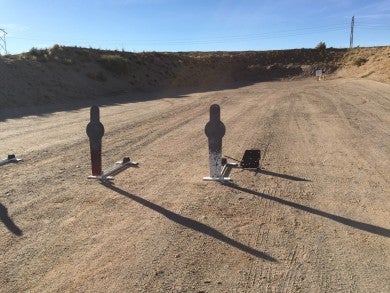
Some pepper poppers. Note the device to the right of the rightmost target–that is one of the clay throwers.
This particular club runs “open” matches meaning you can shoot whatever in terms of optics and platforms. Hi-cap or limited capacity. .223 Rem up to .308 Win. Pump shotgun up to magazine fed. It hosts two matches a month: the second Sunday is a close distance course (rifle is no further than 100 meters), the fourth Saturday is a long range match (with distances past 400 meters). In months lucky enough to have a fifth Saturday, there is also a match.
Anything Goes, You Say?
There are five main classifications of 3-Gun matches and it is helpful to know the main difference between each (the descriptions are directly from 3-Gun Nation). I have to say, “Outlaw Open” is pretty intriguing… 🙂
Limited: “This is the entry-level division due to the light equipment requirements. It’s also one of the more fun divisions in which to participate. You are allowed one unmagnified optic on the rifle (iron sights or red dot) and no bipods. No porting or optic on the shotgun is allowed. It can be semi-auto or pump, 8+1 rounds maximum, but no detachable magazines. Also, the shotgun can’t be loaded using speed-loaders during the stage; each round of ammo must be loaded by hand into the magazine. Handgun also must have no porting or optics, and must have a maximum magazine length of 141.25mm.”
Tactical: “This is the most popular division with the stiffest competition among 3-gun competitors. The only difference from the Limited division is that the optic on the rifle may be magnified.”
Heavy Metal (HeMan): “The rifle must be 7.62×51 or larger with iron sights only; the shotgun must be a 12-gauge pump with iron sights and no porting; the handgun must be .45ACP or larger with no optics or porting only.”
Open: “The “almost anything goes” division. Handgun magazines must be 171.25 mm or less in length. This division also allows speed-loaders for the shotguns during stages.”
Outlaw Open: “As long as it’s safe, everything really does go in this division.”
Scoring? I Guess. If You Must…
Like I said, I’m not really into the competition side, and so I really didn’t care much about the scoring. Since I recognize that some people do, here is the quick view of how our matches are run (there are a bunch of different scoring variations, so if you get involved, and if you care about such things, make sure you ask). The way we ran our match was scored based on time. A timer recorded the match, and your score was based on that total time plus any penalties you acquired; from failure to engage or failure to neutralize targets. Additionally certain targets carried a higher penalty for failure to neutralize (to penalize you for attempting to “game” the system by just chucking some rounds at a target and taking the penalty, rather than fully neutralizing it–I’m talking to you “Texas Star”).
My First Match
Before the match, but after the course was setup, everyone started “walking the course”. Basically a slow walkthrough using pew-pew-pew fingers, to formulate a plan for the course of fire. Looking at the angles. Looking for targets. Determining order of targets. One thing I immediately noticed (but didn’t correlate to anything at the time) was that some of the participants even simulated changing magazines and loading shells into “air” shotguns. This was very reminiscent of the early CQB portions of the shooting package we ran pre-deployment. I would later associate that the people that fully simulated the run a few times, generally ran the course faster and smoother. Weird how visualization and dry drills actually can make a difference… 🙂

The real reason for anodizing and/or cerakoting is so you can find your guns on the rack… Note Romo’s “Stormtrooper” theme on the right.
My first run, of my very first match was a bit of a debacle. John was my timer and I had him give me walking instructions as I went. The order of battle was rifle against three self-resetting steel targets at 90 meters from three different firing positions on opposite sides of the range (prone on the left, behind a barricade in the middle and standing behind a barrel on the right). From there it was a transition to shotgun, and engaging 13 targets (some angle iron stakes with clays hung on them, a few large pepper poppers, a slug target out at 40 meters, and two pepper poppers with a clay thrower on a trip lever). After that was the pistol part of the stage, and that had some pepper poppers, and some USPSA cardboard silhouettes setup as shoot/no shoot targets (you may as well remove the hostage from the equation, or so one of my shots would later indicate).
Transitions are affected by grounding your clear and safed gun in a carpet lined box (some courses have you ground the weapon in a barrel or some other container). The general rule is that no one goes down range of a loaded gun; the breaking of results in a disqualification (and likely ridicule and flogging). The deposit box for the rifle had the shotgun pre-staged with a couple of shells in the tube (okay because no one was downrange from it). Pistol (for this match) was staged in your personal holster in “Condition 2” (or “1”, based on your platform). After completing the shotgun stage and grounding the safed and empty weapon, then you could draw pistol and engage targets. After completing the course of fire, you take your pistol to “Condition 4”, range is declared cold and everyone goes down range to score and reset the range.
So, the debacle. No, I didn’t have a negligent discharge… 🙂 I started on the prone shoot for rifle (you could choose which position to start from). Did I mention this was my very first time firing my Modern Musket? Luke had done a super quick laser bore sight zero for me at BMC, and I literally picked it up the previous evening at the shop–so I had no opportunity to BZO. Anyway I engaged my rifle targets figuring out how to use the Lucid HD7 on the fly. Six shots later I had neutralized my targets (so a pretty good “out of the box” experience considering the target was an black eight-inch steel square in a shaded area and the friggen 2MOA red dot was on the “OMG bright” setting). I flicked my rifle to safe, kept the muzzle downrange and got up to transition to the middle of the range for the rifle barricade shoot. Did I also mention that all of my shotgun shells started out in my dump pouch. Operative part of that sentence being “started out”. Yeah, I left half of them on the shooting mat. Oh well. I got to my firing position and engaged my three targets, neutralizing them in five shots. I moved to the final rifle firing position and engaged, also completing in five shots. I transitioned to shotgun after dropping my magazine, ejecting the round in the chamber, and swapping the rifle for the shotgun in the box. “Okay,” I thought, “I’m liking this Modern Musket, and despite the shotgun shell thing, this is going smooth…”. Yep, I jinxed myself (if you believe in such a thing).
I keep my weapons clean and serviceable. My shotgun was no exception. But I also had not fired it in about four years. And I had never fired anything smaller than #4 shot through it. Absolute largest allowed on the course was #6, though preferably #7 1/2 lead (to prevent wrecking the pepper poppers). I had dutifully bought some #7 1/2 (half of which was back on the shooter’s mat from the first part of the run). I chambered my first round, and then set about loading up my tube. A skill I had also not practiced in about 4 years. And boy was I rusty. Which means not smooth and fast (as the phrase goes, I was slow and rough). I finally got my shells loaded, and engaged my first target. BOOM! Target dropped. Except no shell ejected. WTF. I manually cycled the action (let me just mention how awkward doing failure drills on an 11-87 is). Engaged next target. BOOM! Target dropped. AGAIN no shell ejected. Wash, rinse, repeat. After my 4th failure to eject I realize my semi-auto shotgun is now a poorly designed single shot. I completed the shotgun portion, missing the thrown clays and the slug. I grounded it, and deployed my pistol.
I had been coached to just hammer pair each of the cardboard pistol targets (two shots anywhere, or a single in the “A”, was considered a neutralization), and lay down fury and hate onto the steel targets (9mm cheap Wolf ammo is not quite the same as +P ammo, or .45ACP, in case you were wondering). Overall the pistol stage went pretty smooth (despite one of the hostage targets panicking and throwing itself in front of my round; the round which incidentally still also hit the “bad guy”–alas, the scorers would not give me the point, even though I’m pretty sure I once heard something about “just take the hostage out of the equation”). I finished out the stage with a burly 312 seconds (after penalties were totalled). For comparison, Jared ran the entire course in 74 seconds (and I think John was 78 seconds, but don’t quote me on that).
I collected my weapons, and took the shotgun back to my mobile workbench (aka the back of my Jeep) and proceeded to disassemble it. Everything looked fine. Then I remembered. It was ported for heavy loads. Sigh. Nothing I can fix in the field (nor really want to).
Romo let me borrow his shotgun (an FN SLP MK1) for my next run and things went much smoother and I brought in a sub four-minute time. Stupid hostages…
Lessons Learned
While it was really interesting to see what the difference between the “competitive” participants and everyone else was, (skill and gear), I think the biggest take away is actually something that is very valuable in the realm of self-defense shooting (I am under no illusion that 3-Gun remotely resembles combat, by the way). The shell holders (and other tricked out gear), while “cool” are not really the “thing” that makes 3-Gun something with value apart from the competition.
What I think the most useful thing you can put into practice and get timely feedback on is the visualization of the problem, and clean and smooth weapon handling. Watching the top performers of the match, as I mentioned before, showed that they took the time to think (and walk) through the different angles they would need to engage and the best order to engage those target placements. The “real-world” application of this would be doing the same for, say, a home defense scenario. How many people here do a regular dry-fire walkthrough of your residence? Things like practicing acquiring targets around corners, navigating hallways/rooms/obstacles (like chairs, toys, etc), and moving from cover and concealment to better cover and concealment (and even knowing where, and if, they exist in your house). I would guess far fewer people than those that go regularly to the range and just shoot on paper. Heck, I rarely even do that.
Another difference in how fast and smooth the performance went was related to target selection. For example, during the shotgun stage, we had six clays mounted on stakes, four pepper poppers (two of which had clay launchers that fired when the steel plate dropped), and medium range slug target. The fast shooters would hit the clays (with six shells in the gun), reload two shot shells, one slug, and four more shot shells. What this allowed them to do was rapidly knock down all four pepper poppers, engage the slug target, and by that point, the clays were being launched, and the shooter had two shells left for them. Slow people like me would engage the pepper popper attached to the clay launcher, wait for the clay to launch, engage it, and then move to the next target.
The last big observation I had was watching how the top performers manipulate their weapons. The biggest speed difference was related to the skill of reloading and bringing a weapon back online (specifically reloading the shotgun as that is mechanically the slowest reload, and there is typically variation in the types of rounds used: shot versus slugs, so you have to think through the reload, rather than just slamming home a new magazine).
But Tom, I Really Like To Compete!
If you are a competitive sort, there are a number of large competitions. The largest annual events in the USA are the USPSA 3-Gun Nationals, the Rocky Mountain 3-Gun, the DPMS Tri-Gun Challenge, the Superstition Mountain Mystery 3-Gun, and the Larue Tactical Multigun Championship. If you like that kind of thing, go for it. Get yourself a little red wagon, or Nepalese sherpa, to portage your gear (I’m not entirely kidding here), get some “cool guy” gear and go for it. Actually the events do look kind of fun… 🙂
Conclusion
Overall, participating in 3-Gun has been one of the more rewarding experiences of my shooting career, post-Recon. Just like any semi-organized “sport”, you are going to have some “ultra-competitive” people. For the most part, the people that I have met and interacted with have been humble, great individuals, and there is always something you can learn at a match, be it from someone else, or by having your equipment spectacularly fail at the worst time.
If you treat it as a opportunity to practice your visualization and planning all the way to execution and weapon manipulation skills while under a little bit of friendly pressure, I think you will gain a lot of useful feedback, and also have a great deal of fun.
I would highly recommend finding a club near you and getting involved. Go try a match. You might be surprised.
But beware. It could become addictive and entice you to buy or upgrade your equipment. I’ve since traded in my 11-87 for a Mossberg 930 JM Pro and started making performance upgrades to my Glock 17. Though I have not yet bought a crazy modular belt system, or any of those goofy shot shell holders… 🙂
 Your Privacy Choices
Your Privacy Choices

